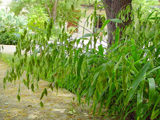Native Plants

Q. Who is Mr. Smarty Plants?
A: There are those who suspect Wildflower Center volunteers are the culpable and capable culprits. Yet, others think staff members play some, albeit small, role. You can torture us with your plant questions, but we will never reveal the Green Guru's secret identity.
Did you know you can access the Native Plant Information Network with your web-enabled smartphone?
Ask Mr. Smarty Plants is a free service provided by the staff and volunteers at the Lady Bird Johnson Wildflower Center.

rate this answer
Monday - July 08, 2013
From: Charlottesville, VA
Region: Mid-Atlantic
Topic: Groundcovers, Shade Tolerant
Title: Low-growing plants for a slope in the shade
Answered by: Nan Hampton
QUESTION:
Hello, I'm looking for native plants to put in the shade (within the drip-line) of a well-established American Holly. The area gets deep shade; it is also on a very gentle north-exposure slope. We have dry clay soil in this area. I would like a mix of species that would thrive with little care and eventually spread to cover the ground--but they don't have to be low-growing. Up to 3 feet tall would be fine. Many thanks for your help!ANSWER:
The following plants will grow in the shade and are all less than 3 feet tall or can be maintained at that height by pruning. All should do well in clay soil. I found these plants by doing a COMBINATION SEARCH in our Native Plant Database. I chose "Virginia" from the Select State or Province slot, "Shade" from Light Requirement and "0-1 ft.", "1-3 ft." and"3-6 ft." from size characteristics. You can do the same search to see more possibilities for plants. Be sure the read the entries under GROWING CONDITIONS on each species' page, especially the Soil Description, to be sure the growing conditions meet your site's characteristics.
Ceanothus americanus (New jersey tea) Here is more information from Missouri Botanical Garden.
Coreopsis lanceolata (Lanceleaf coreopsis) is perennial with evergreen foliage and blooms April, May and June.
Phlox divaricata (Wild blue phlox) is perennial with evergreen foliage and blooms March, April and May.
Symphoricarpos orbiculatus (Coralberry) may grow a little taller than you like, but it can be pruned to keep it low. It does well in clay and full shade. It has purple berries that persist into winter. Here is more information from Missouri Botanical Garden and Texas Gardening Info.
Aralia nudicaulis (Wild sarsaparilla) Here is more information from Plants for a Future.
Carex pensylvanica (Pennsylvania sedge) is low-growing, grass-like and semi-evergreen. Here is more information from Missouri Botanical Garden and Illinois Wildflowers.
Chasmanthium latifolium (Inland sea oats) grows very well in shade and part shade and clay soil. The dried seeds are attractive into the winter and can be removed in the spring when the new green leaves begin to form. Here's more information from Nadia's Backyard.
Geum canadense (White avens) with evergreen foliage and blossoms in April, May and June. Here's more information from Plants for a Future.
Packera obovata (Golden groundsel) has evergreen foliage and blooms well in the shade. Here is more information from Missouri Botanical Garden.
From the Image Gallery
More Shade Tolerant Questions
Different shades of green in Taxodium distichum (bald cypress)
June 05, 2008 - I have two bald cypress trees 50 feet apart, but there was very different soil in the two holes. One was a clayey soil and the other was much more the Austin limestone soil. The trees are about 2 ye...
view the full question and answer
Groundcover for part shade in Albany NY
July 02, 2014 - Hello! I'm looking for: a native ground cover, mostly shade with only some morning sun, on a slope, edible is preferred but not necessity, mostly clay type soil for the Albany, NY area. Thanks for yo...
view the full question and answer
Replacement for Love Grass in Michigan
July 27, 2015 - need a replacement for Love Grass at Shops of Willow Bend in Plano. The entire perimeter of this mall has Bermuda and Love Grass. The Elms and Oaks have grown so the Love Grass is mostly gone. Ther...
view the full question and answer
O.K. to grow grass under a live oak?
November 26, 2014 - Is it a bad idea to plant grass around a mature live oak? We have erosion issues and trying to keep mulch in the beds around the tree groves is a challenge, even with edging. Much of the native dirt...
view the full question and answer
Plants to grow under pine trees in Riverside, CA
October 15, 2014 - Please tell me what plants would do well under pine trees in somewhat moist soil in Riverside, Ca. Also, I would prefer perennials that are easy to weed. (I currently have violets which are overrun wi...
view the full question and answer
| Support the Wildflower Center by Donating Online or Becoming a Member today. |

